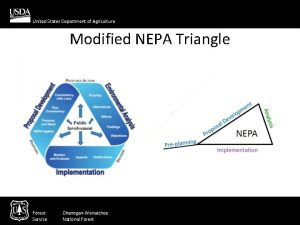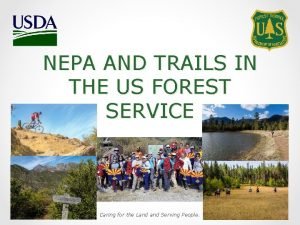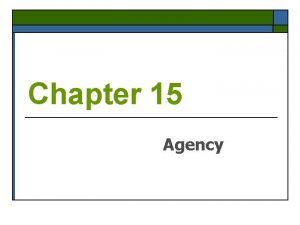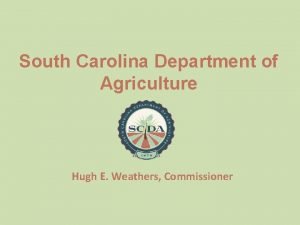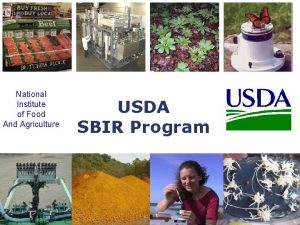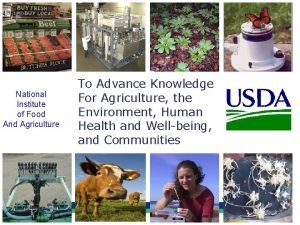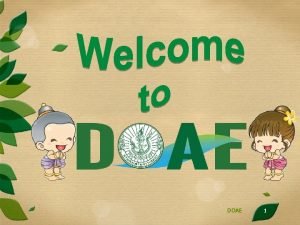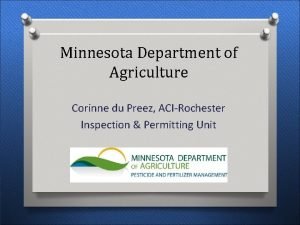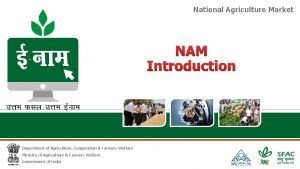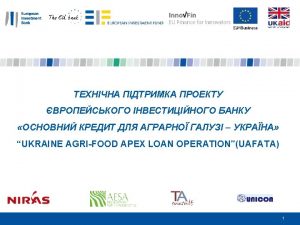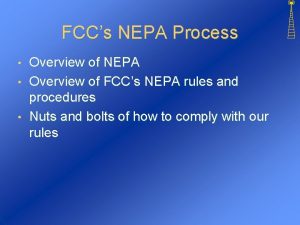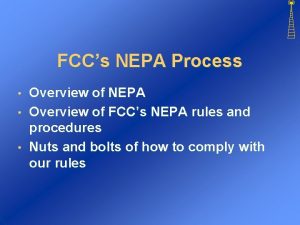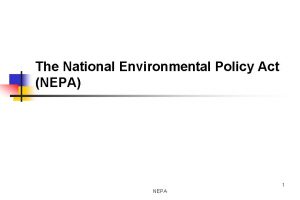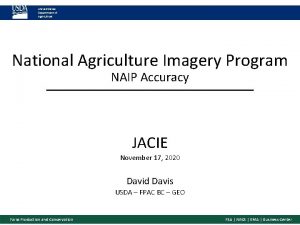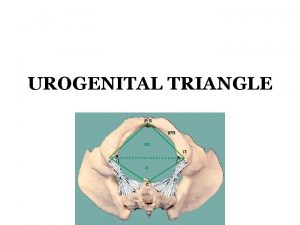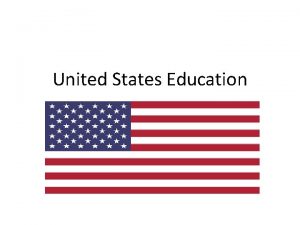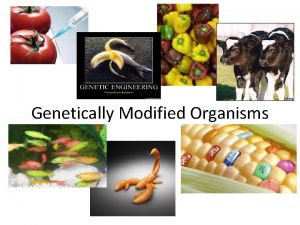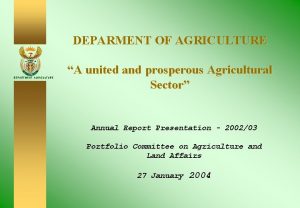United States Department of Agriculture Modified NEPA Triangle











- Slides: 11

United States Department of Agriculture Modified NEPA Triangle Forest Service Okanogan-Wenatchee National Forest

United States Department of Agriculture Upper Wenatchee Pilot Project Forest Service Okanogan-Wenatchee National Forest Wenatchee, WA

United States Department of Agriculture Project Goals Through scientifically-sound restoration treatments, the UWPP will create a more resilient terrestrial and aquatic landscape in the Lower Chiwawa, Big Meadow, Lake Wenatchee, and Beaver Creek. Wenatchee River subwatersheds to: • Address conditions that have departed from the historic range of variability to reduce the risk of uncharacteristic wildfire and other disturbances to protect lives, communities, and ecological values and analyze the effects of restorations treatments used for advancing the landscape toward the desired condition such as thinning and prescribed fire • Promote better outcomes for a broad spectrum of ecological, social, and community resources and values in a manner that recognizes and responds to the important role of natural fire and helps mitigate risk in the wildland urban interface while providing for sustainable user access • Protect and restore watershed conditions that maintain uplands, late-successional habitat and large old trees, riparian and instream habitat, and water quality and quantity for the benefit of communities and native fish and wildlife • Design and implement treatments to support the recovery of threatened, endangered, and sensitive species such as restoring historical patchwork forest structures, addressing fish-passage barriers, and facilitating natural watershed process to improve aquatic habitat. Optimize the production of ecosystem services and forest products to fulfill the stewardship mandate of the Forest Service in a manner that reflects a broad spectrum of ecological, cultural, and socioeconomic values. Forest Service Okanogan-Wenatchee National Forest Wenatchee, WA

United States Department of Agriculture Additionally, the UWPP seeks to develop an effective model for collaboration among the FS, other federal, state and local agencies, local Tribes, the North Central Washington Forest Health Collaborative and member organizations, as well as a wide range of local landowners, community partners and stakeholders. This collaborative planning effort will increase the shared stewardship of the forest and watershed restoration vision and will result in greater support for all management tools needed to implement terrestrial and aquatic treatment actions on this landscape. Forest Service Okanogan-Wenatchee National Forest Wenatchee, WA

United States Department of Agriculture Forest Service Okanogan-Wenatchee National Forest Wenatchee, WA

United States Department of Agriculture Purpose and Need The primary purpose of this project is to create a more resilient terrestrial and aquatic landscape to: – Address conditions that have departed from the historical range of variability to reduce the risk of wildfire and other disturbances to protect lives, communities, and ecological values. – Promote better outcomes for a broad spectrum of ecological, social, and community resources and values in a manner that recognizes and responds to the important role of natural fire and helps mitigate risk in the wildland urban interface while providing for sustainable user access. – Protect and restore watershed conditions that maintain uplands, late-successional habitat and large and old trees, riparian and instream habitat, and water quality and quantity for the benefit of communities and native fish and wildlife. – Design and implement treatments to support the recovery of threatened, endangered, and sensitive species. Forest Service Okanogan-Wenatchee National Forest Wenatchee, WA

United States Department of Agriculture Need • • • Create and maintain successional pathways that provide the amount and spatial arrangement of forest conditions that increase resilience to natural disturbance and sustainability. Improve habitat conditions within Late-Successional Reserves while reducing risk to stand replacing fires. Maintain, enhance, or accelerate the development of large and old trees and increase proportion of old forest structure. Conserve the existing spotted owl and old forest habitat, and identify and implement vegetation treatments to develop additional habitat in the most sustainable landscape location. Support biodiversity by restoring, enhancing, and/or maintaining unique habitats including aspen, white bark pine, meadows, and huckleberry fields. Reduce impacts from fire and return fire as a natural element of the landscape. Reduce risk of fire on National Forest System lands in the Wildland Urban Interface. Improve habitat connectivity for Chinook Salmon, Bull Trout, and Steelhead by removing barriers to fish passage. Improve aquatic habitat, including instream, riparian, banks, and floodplains Reduce road related impacts to improve terrestrial and aquatic habitat quality (connectivity, disturbance, sediment). Forest Service Okanogan-Wenatchee National Forest Wenatchee, WA

United States Department of Agriculture Condition-Based Management Strategy • “Flexible toolbox approach” is a condition-based management strategy that allows predetermined treatments to be aligned, prior to implementation, with current conditions on the ground. • With the flexible toolbox approach, a suite of potential treatment types and intensities are proposed analyzed as a response to specific resource conditions. Forest Service Okanogan-Wenatchee National Forest Wenatchee, WA

United States Department of Agriculture Why invest in landscape evaluation? • Each Landscape Evaluation can support multiple project NEPA decisions. • Purpose and need statements and proposed actions will be better supported with landscape- and patch-level information. This should result in fewer misidentified proposed treatment areas and missed treatment opportunities, improving layout efficiency of projects. • Better integration across resource disciplines will reduce resource conflicts and provide a high level of ownership in restoration projects. • Landscape Evaluations will provide better information on which to base decisions about the location, scope, and priority of various potential projects, so that limited resources for treatments are used where they provide the greatest benefits. • A focused project design and integrated purpose and need statement should simplify the NEPA process by reducing unresolved conflict and limiting alternative development. Forest Service Okanogan-Wenatchee National Forest Wenatchee, WA

United States Department of Agriculture • Treatment options can be modeled to show potential outcomes and effects. This should make treatments more effective and simplify NEPA effects analysis. • Integrated Landscape Evaluations across ownership boundaries and resource areas allow for collaboration and funding opportunities to accomplish additional work. • Early involvement in the planning process adds value to collaborative group members, in terms of understanding forest conditions, prospects for successful restoration, and any potential adverse effects that restoration may cause, that then results in improved Forest Service decisions. • Extensive engagement with the NCWFHC during the pre-planning and project development phases ensured that objectives of the project were thoughtfully articulated and broadly supported. Forest Service Okanogan-Wenatchee National Forest Wenatchee, WA

United States Department of Agriculture Questions? ? ? Forest Service Okanogan-Wenatchee National Forest Wenatchee, WA
 Nepa triangle
Nepa triangle Nepa triangle
Nepa triangle Nepa cil acting as agent
Nepa cil acting as agent Sc department of agriculture
Sc department of agriculture Department of agriculture sbir
Department of agriculture sbir Department of agriculture sbir
Department of agriculture sbir Florida dept of agriculture and consumer services
Florida dept of agriculture and consumer services Production doae
Production doae Virginia department of agriculture and consumer services
Virginia department of agriculture and consumer services Minnesota department of agriculture
Minnesota department of agriculture Site:slidetodoc.com
Site:slidetodoc.com Department of agriculture
Department of agriculture
